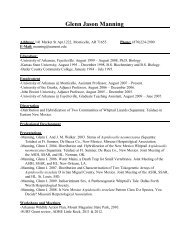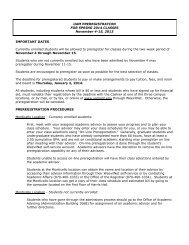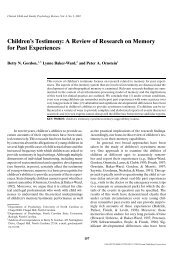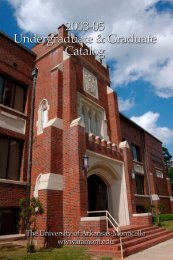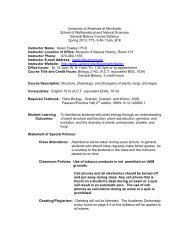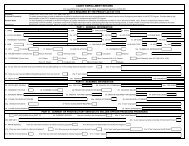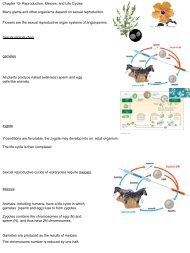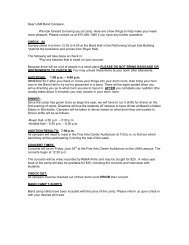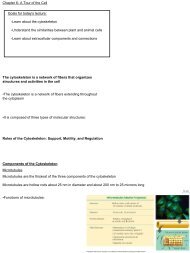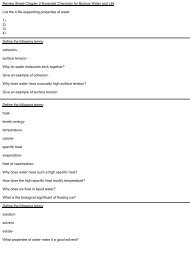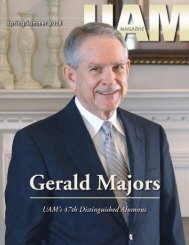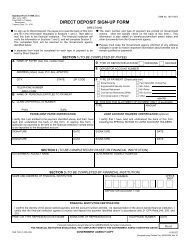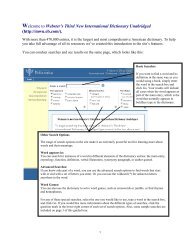A TAAP - University of Arkansas at Monticello
A TAAP - University of Arkansas at Monticello
A TAAP - University of Arkansas at Monticello
Create successful ePaper yourself
Turn your PDF publications into a flip-book with our unique Google optimized e-Paper software.
A <strong>TAAP</strong><br />
<strong>Arkansas</strong> Comprehensive Testing, Assessment, and Accountability Program<br />
Released Item Booklet<br />
Geometry<br />
End-<strong>of</strong>-Course Examin<strong>at</strong>ion<br />
April 2007 Administr<strong>at</strong>ion<br />
This document is the property <strong>of</strong> the <strong>Arkansas</strong> Department <strong>of</strong> Educ<strong>at</strong>ion, and all rights <strong>of</strong> this document are<br />
reserved by the <strong>Arkansas</strong> Department <strong>of</strong> Educ<strong>at</strong>ion. <strong>Arkansas</strong> public schools may reproduce this document<br />
in full or in part for use with teachers, students, and parents. All other uses <strong>of</strong> this document are forbidden<br />
without written permission from the <strong>Arkansas</strong> Department <strong>of</strong> Educ<strong>at</strong>ion. All inquiries should be sent to<br />
Dr. Gayle Potter <strong>at</strong> the <strong>Arkansas</strong> Department <strong>of</strong> Educ<strong>at</strong>ion, 501-682-4558.<br />
<strong>Arkansas</strong> Department <strong>of</strong> Educ<strong>at</strong>ion
Table <strong>of</strong> Contents––April 2007<br />
i<br />
PAGE<br />
PART I Overview .........................................................................................................................................1<br />
PART II Geometry Released Items with Correct Responses & Rubrics ...........................................2–35<br />
Released Items ...........................................................................................................................2–34<br />
End-<strong>of</strong>-Course M<strong>at</strong>hem<strong>at</strong>ics Reference Sheet...............................................................................35<br />
PART III The <strong>Arkansas</strong> Geometry M<strong>at</strong>hem<strong>at</strong>ics Curriculum Framework......................................36–37<br />
PART IV Item Correl<strong>at</strong>ion with Curriculum Framework .......................................................................38
PART I Overview––April 2007<br />
The criterion-referenced tests implemented as part <strong>of</strong> the <strong>Arkansas</strong> Comprehensive Testing, Assessment, and<br />
Accountability Program (AC<strong>TAAP</strong>) are being developed in response to <strong>Arkansas</strong> Legisl<strong>at</strong>ive Act 35, which<br />
requires the St<strong>at</strong>e Board <strong>of</strong> Educ<strong>at</strong>ion to develop a comprehensive testing program th<strong>at</strong> includes assessment <strong>of</strong><br />
the challenging academic content standards defined by the <strong>Arkansas</strong> Curriculum Frameworks.<br />
As part <strong>of</strong> this program, students in <strong>Arkansas</strong> public schools who had completed or were completing Geometry<br />
by the end <strong>of</strong> the spring semester particip<strong>at</strong>ed in the Geometry End-<strong>of</strong>-Course Examin<strong>at</strong>ion in April 2007.<br />
This Released Item Booklet for the Geometry End-<strong>of</strong>-Course Examin<strong>at</strong>ion contains test questions or items th<strong>at</strong><br />
were asked <strong>of</strong> students during the April 2007 oper<strong>at</strong>ional administr<strong>at</strong>ion. The test items included in Part II <strong>of</strong><br />
this booklet are those items th<strong>at</strong> contributed to the student performance results for th<strong>at</strong> administr<strong>at</strong>ion.<br />
Students were given approxim<strong>at</strong>ely two hours each day to complete assigned test sessions during the two days<br />
<strong>of</strong> testing in April 2007. Students were permitted to use a calcul<strong>at</strong>or for both multiple-choice and open-response<br />
items. Students were also supplied with a reference sheet to be used so th<strong>at</strong> all students would have equal access<br />
to this inform<strong>at</strong>ion during testing. (See the reference sheet on page 35 <strong>of</strong> this booklet.) All <strong>of</strong> the multiplechoice<br />
items within this booklet have the correct response marked with an asterisk (*). The open-response<br />
questions are listed with scoring guides (rubrics) immedi<strong>at</strong>ely following. These rubrics provide inform<strong>at</strong>ion on<br />
the scoring model used for Geometry.<br />
The development <strong>of</strong> the Geometry End-<strong>of</strong>-Course Examin<strong>at</strong>ion was based on the <strong>Arkansas</strong> Geometry<br />
M<strong>at</strong>hem<strong>at</strong>ics Curriculum Framework. This framework has distinct levels: Strands to be taught in concert,<br />
Content Standards within each Strand, and Student Learning Expect<strong>at</strong>ions within each Content Standard. An<br />
abridged version <strong>of</strong> the <strong>Arkansas</strong> Geometry M<strong>at</strong>hem<strong>at</strong>ics Curriculum Framework can be found in Part III <strong>of</strong> this<br />
booklet. It is important to note th<strong>at</strong> this abridged version lists only the predominant Strand, Content Standard,<br />
and Student Learning Expect<strong>at</strong>ion associ<strong>at</strong>ed with each item. However, since many key concepts within the<br />
<strong>Arkansas</strong> Geometry M<strong>at</strong>hem<strong>at</strong>ics Curriculum Framework are interrel<strong>at</strong>ed, in many cases there are other item<br />
correl<strong>at</strong>ions or associ<strong>at</strong>ions across Strands, Content Standards, and Student Learning Expect<strong>at</strong>ions.<br />
Part IV <strong>of</strong> the Released Item Booklet contains a tabular listing <strong>of</strong> the Strand, Content Standard, and Student<br />
Learning Expect<strong>at</strong>ion th<strong>at</strong> each question was designed to assess. The multiple-choice and open-response items<br />
found on the Geometry End-<strong>of</strong>-Course Examin<strong>at</strong>ion were developed in close associ<strong>at</strong>ion with the <strong>Arkansas</strong><br />
educ<strong>at</strong>ion community. <strong>Arkansas</strong> teachers particip<strong>at</strong>ed as members <strong>of</strong> the Geometry Content Advisory<br />
Committee, providing routine feedback and recommend<strong>at</strong>ions for all items. The number <strong>of</strong> items associ<strong>at</strong>ed<br />
with specific Strands, Content Standards, and Student Learning Expect<strong>at</strong>ions was based on approxim<strong>at</strong>e<br />
proportions suggested by the Content Advisory Committee, and their recommend<strong>at</strong>ions were accommod<strong>at</strong>ed to<br />
the gre<strong>at</strong>est extent possible given the overall test design. Part IV <strong>of</strong> the Released Item Booklet provides<br />
<strong>Arkansas</strong> educ<strong>at</strong>ors with specific inform<strong>at</strong>ion on how the Geometry End-<strong>of</strong>-Course Examin<strong>at</strong>ion items align or<br />
correl<strong>at</strong>e with the <strong>Arkansas</strong> Geometry M<strong>at</strong>hem<strong>at</strong>ics Curriculum Framework to provide models for classroom<br />
instruction.<br />
1
ARGM03M0302Y380-380B<br />
1. The diameter <strong>of</strong> a tractor tire is 5 feet.<br />
Rounded to the nearest hundredth, how far<br />
will the tractor move when the wheel rot<strong>at</strong>es<br />
once? Use π = 3.14.<br />
5 ft<br />
A. 7.85 feet<br />
* B. 15.70 feet<br />
C. 19.63 feet<br />
D. 78.50 feet<br />
ARGM05R0401Y401-401C<br />
2. Wh<strong>at</strong> is the measure <strong>of</strong> ∠E in the<br />
parallelogram below?<br />
H<br />
A. 35°<br />
B. 55°<br />
* C. 145°<br />
D. 155°<br />
PART II Geometry Released Items––April 2007<br />
E F<br />
G<br />
2<br />
ARGM04L0105Y407-407D<br />
3. An engineer designed a steel beam, shown<br />
below. The horizontal parts th<strong>at</strong> form the top<br />
and bottom are parallel. To build the cross<br />
pieces, the engineer needs to know the<br />
measure <strong>of</strong> the angles shown. The measure <strong>of</strong><br />
∠1 = 110 degrees and m∠2 = 105 degrees.<br />
Wh<strong>at</strong> are the measures <strong>of</strong> ∠3 and ∠4?<br />
3 4<br />
1 2<br />
A. m∠3 = 70°, m∠4 = 65°<br />
B. m∠3 = 65°, m∠4 = 70°<br />
C. m∠3 = 110°, m∠4 = 105°<br />
* D. m∠3 = 105°, m∠4 = 110°<br />
ARGM05C0501NXXX-542C<br />
4. Wh<strong>at</strong> is the midpoint <strong>of</strong> a segment with<br />
endpoints <strong>of</strong> (–3, 5) and (8, –17)?<br />
A. (3, –6)<br />
B. (5, –12)<br />
* C. (2.5, –6)<br />
D. (–5.5, –9.5)
ARGM02T0201Y232-232D<br />
5. The triangles below are similar. Wh<strong>at</strong> is the<br />
value <strong>of</strong> x?<br />
8<br />
B<br />
A 4 C<br />
A. –4<br />
B. 3<br />
C. 4<br />
* D. 6<br />
PART II Geometry Released Items––April 2007<br />
x<br />
E<br />
D F<br />
ARGM03L0101NXXX-315D<br />
6. Lewis wrote the st<strong>at</strong>ements below about four<br />
constell<strong>at</strong>ions: Cygnus, Hercules, Leo, and<br />
Pegasus.<br />
• The constell<strong>at</strong>ion Cygnus appeared after<br />
the constell<strong>at</strong>ion Hercules.<br />
• The constell<strong>at</strong>ion Hercules appeared after<br />
the constell<strong>at</strong>ion Leo.<br />
• The constell<strong>at</strong>ion Leo appeared before the<br />
constell<strong>at</strong>ion Cygnus.<br />
• The constell<strong>at</strong>ion Pegasus appeared after<br />
the constell<strong>at</strong>ion Cygnus.<br />
In wh<strong>at</strong> order did the constell<strong>at</strong>ions appear?<br />
A. Cygnus, Pegasus, Leo, Hercules<br />
B. Leo, Cygnus, Pegasus, Hercules<br />
C. Leo, Cygnus, Hercules, Pegasus<br />
* D. Leo, Hercules, Cygnus, Pegasus<br />
3<br />
ARGM05C0501Y503-503A<br />
7. A portion <strong>of</strong> rectangle QRST has been<br />
graphed on a plane.<br />
Q<br />
y<br />
T<br />
R<br />
Wh<strong>at</strong> is the slope <strong>of</strong> line RS?<br />
* A. 3<br />
−<br />
2<br />
B. 2<br />
−<br />
3<br />
C. 2<br />
3<br />
D. 3<br />
2<br />
ARGM05M0304NXXX-320B<br />
8. A meter stick is held perpendicular to the<br />
ground. It forms a shadow th<strong>at</strong> is 1.8 m long.<br />
At the same time, a flagpole forms a shadow<br />
th<strong>at</strong> is 7.2 m long. How tall is the flagpole?<br />
A. 0.25 m<br />
* B. 4 m<br />
C. 9 m<br />
D. 12.96 m<br />
x
PART II Geometry Released Items––April 2007<br />
ARGM03R0401Y326-326C<br />
9. Figure ABCD below is a quadril<strong>at</strong>eral. Wh<strong>at</strong><br />
is the value <strong>of</strong> x?<br />
A. 15<br />
B. 40<br />
* C. 45<br />
D. 65<br />
ARGM05T0204Y214-214A<br />
10. A 12-foot tower is to be anchored by a wire<br />
running from the top <strong>of</strong> the tower to a point<br />
5 feet from the bottom <strong>of</strong> the tower. Wh<strong>at</strong> is<br />
the length <strong>of</strong> the wire?<br />
* A. 13 ft<br />
B. 17 ft<br />
C. 34 ft<br />
D. 169 ft<br />
12 ft<br />
Tower<br />
5 ft<br />
Wire<br />
4<br />
ARGM02C0501NXXX-254D<br />
11. The coordin<strong>at</strong>es <strong>of</strong> point A are (–2, 3). The<br />
coordin<strong>at</strong>es <strong>of</strong> the midpoint <strong>of</strong> AB are (6, 1).<br />
Wh<strong>at</strong> are the coordin<strong>at</strong>es <strong>of</strong> point B?<br />
A. (2, 2)<br />
B. (4, –1)<br />
C. (–4, 2)<br />
* D. (14, –1)<br />
ARGM05L0103Y112-112C<br />
12. The figure below represents Pascal’s Triangle.<br />
The sum <strong>of</strong> the numbers in Row 1 is 1, the<br />
sum <strong>of</strong> Row 2 is 2, and the sum <strong>of</strong> Row 3 is 4.<br />
Row 1<br />
1<br />
Row 2<br />
1 1<br />
Row 3 1 2 1<br />
Row 4 1 3 3 1<br />
Row 5 1 4 6 4 1<br />
If this p<strong>at</strong>tern continues, wh<strong>at</strong> is the sum <strong>of</strong><br />
the numbers in Row 7?<br />
A. 10<br />
B. 32<br />
* C. 64<br />
D. 128<br />
ARGM03M0302NXXX-325D<br />
13. The circumference <strong>of</strong> a cylindrical fire<br />
hydrant is 33 inches. How many inches is the<br />
diameter <strong>of</strong> the fire hydrant, rounded to the<br />
nearest hundredth? Use π = 3.14.<br />
A. 3.24 inches<br />
B. 5.25 inches<br />
C. 6.48 inches<br />
* D. 10.51 inches
PART II Geometry Released Items––April 2007<br />
ARGM05T0201Y243-243D<br />
14. Cecelia wants to find the height <strong>of</strong> a tree by measuring shadows, as shown in the figure below. The length<br />
<strong>of</strong> the tree’s shadow is 6 m long, and Cecelia’s shadow is 0.8 m long. Cecelia is 1.6 m tall.<br />
1.6 m<br />
0.8 m 6 m<br />
Wh<strong>at</strong> is the height <strong>of</strong> the tree, to the nearest meter?<br />
A. 3 m<br />
B. 8 m<br />
C. 14 m<br />
* D. 12 m<br />
ARGM05C0502NXXX-549B<br />
15. A line is represented by the equ<strong>at</strong>ion<br />
y = 12x + 33. Which equ<strong>at</strong>ion represents a line<br />
th<strong>at</strong> is parallel to this line?<br />
A. y = 3x – 8<br />
* B. y = 12x – 19<br />
C. y = 12x + 33<br />
D. y = – 1<br />
x + 7<br />
12<br />
5<br />
ARGM03R0401NXXX-344A<br />
16. Which st<strong>at</strong>ement is always true?<br />
?<br />
* A. All squares are rhombi.<br />
B. All rectangles are squares.<br />
C. All parallelograms are rectangles.<br />
D. All quadril<strong>at</strong>erals are parallelograms.
PART II Geometry Released Items––April 2007<br />
ARGM02L0103Y253-253B<br />
17. Wh<strong>at</strong> is the 7th number in the p<strong>at</strong>tern below?<br />
A. 11<br />
* B. 20<br />
C. 23<br />
D. 30<br />
2 5 8<br />
ARGM03M0302NXXX-345D<br />
18. Lucy measures the circumference <strong>of</strong> a circular<br />
pie pan. It is 30 inches. Wh<strong>at</strong> is the diameter<br />
<strong>of</strong> the pie pan? Use π = 3.14.<br />
A. 3.09 inches<br />
B. 4.78 inches<br />
C. 6.18 inches<br />
* D. 9.55 inches<br />
ARGM04R0401NXXX-415A<br />
19. Michelle is cutting pieces <strong>of</strong> wood to make<br />
shelves. Which must be true if Michelle’s<br />
shelves are rectangular?<br />
* A. The diagonals are congruent.<br />
B. There are four congruent sides.<br />
C. The diagonals are perpendicular.<br />
D. The consecutive interior angles are not<br />
congruent.<br />
6<br />
ARGM05T0201Y241-241C<br />
20. Which theorem can be used to show th<strong>at</strong> the<br />
two triangles below are congruent?<br />
7<br />
A. AAA<br />
B. ASA<br />
* C. SAS<br />
D. SSS<br />
9<br />
9<br />
7
ARGM04C0501Y416-416B<br />
21. Which are the coordin<strong>at</strong>es <strong>of</strong> the midpoint <strong>of</strong><br />
AB shown below?<br />
A. (–2, 2)<br />
* B. (–1, 1)<br />
C. (1, –1)<br />
D. (0, 2)<br />
PART II Geometry Released Items––April 2007<br />
ARGM02L0104NXXX-215D<br />
22. Ray AB is an angle bisector <strong>of</strong> ∠FAC. Which<br />
st<strong>at</strong>ement must be true?<br />
A. Angle FAB and ∠ BAC each measure<br />
45°.<br />
B. Angle FAB and ∠ BAC are<br />
complementary angles.<br />
C. Angle FAB and ∠ BAC are a linear pair.<br />
* D. Angle FAB and ∠ BAC are congruent.<br />
7<br />
ARGM02M0302Y246-246C<br />
23. The surface area <strong>of</strong> the sphere below is 4πr 2 .<br />
If the radius were to be divided by 2, how<br />
would the surface area be affected?<br />
A. The surface area would be 16 times<br />
smaller.<br />
B. The surface area would be 8 times<br />
smaller.<br />
* C. The surface area would be 4 times<br />
smaller.<br />
D. The surface area would be 2 times<br />
smaller.<br />
ARGM05R0407N459-459D<br />
24. Which best describes an orthographic drawing<br />
<strong>of</strong> the top view <strong>of</strong> a cone?<br />
A. a point<br />
B. a sphere<br />
C. a triangular shape<br />
* D. a circle with a point in the center<br />
r
PART II Geometry Released Items––April 2007<br />
ARGM05T0203Y250-250A<br />
25. In which figure is point P on a perpendicular bisector <strong>of</strong> the triangle?<br />
*<br />
A.<br />
Z Y<br />
C. D.<br />
X<br />
P<br />
X<br />
Z Y<br />
ARGM02R0402NXXX-213B<br />
26. Wh<strong>at</strong> is the measure <strong>of</strong> each interior angle <strong>of</strong> a<br />
regular decagon?<br />
A. 126°<br />
* B. 144°<br />
C. 162°<br />
D. 180°<br />
ARGM02C0504NXXX-235A<br />
27. The equ<strong>at</strong>ion <strong>of</strong> a circle in standard form is<br />
(x – 3) 2 + (y + 6) 2 = 25. Wh<strong>at</strong> is the center<br />
point <strong>of</strong> the circle?<br />
* A. (3, –6)<br />
B. (–3, 6)<br />
C. (6, –3)<br />
D. (–6, 3)<br />
P<br />
B.<br />
8<br />
P<br />
X<br />
Z<br />
Z<br />
X<br />
P<br />
ARGM03L0104Y314-314D<br />
28. Wh<strong>at</strong> is the r<strong>at</strong>io <strong>of</strong> m∠2 to m∠3?<br />
A. 36<br />
36<br />
B. 144<br />
108<br />
C. 108<br />
36<br />
* D. 144<br />
36<br />
Y<br />
2<br />
Y<br />
3
ARGM05M0301Y305-305A<br />
PART II Geometry Released Items––April 2007<br />
29. Below are four targets th<strong>at</strong> will be used for the beanbag toss <strong>at</strong> the school carnival. Assuming the beanbag<br />
2<br />
hits the target, which target has a probability <strong>of</strong> the beanbag landing on a shaded section?<br />
9<br />
* A. Target 1<br />
B. Target 2<br />
C. Target 3<br />
D. Target 4<br />
Target 1 Target 2<br />
Target 3<br />
ARGM05T0203Y252-252B<br />
30. In the figure below, CE is an angle bisector. Wh<strong>at</strong> is the value <strong>of</strong> x?<br />
A. 4<br />
* B. 8<br />
C. 13<br />
D. 25<br />
C<br />
A<br />
9<br />
13<br />
E<br />
Target 4<br />
17<br />
B
PART II Geometry Released Items––April 2007<br />
ARGM02C0501Y223-223C<br />
31. Wh<strong>at</strong> is the length <strong>of</strong> the longest side <strong>of</strong> ∆ABC?<br />
A. 45<br />
B. 109<br />
* C. 178<br />
D. 256<br />
12<br />
11<br />
10<br />
9<br />
8<br />
7<br />
6<br />
5<br />
4<br />
3<br />
2<br />
1<br />
A (0, 0)<br />
0<br />
y<br />
B (3, 6)<br />
ARGM02L0104Y233-233A<br />
32. Point M is loc<strong>at</strong>ed on AB . Wh<strong>at</strong> is the value<br />
<strong>of</strong> x?<br />
* A. 18<br />
B. 36<br />
C. 90<br />
D. 180<br />
1 2 3 4 5 6 7 8 9 10 11 12 13 14<br />
10<br />
C (13, 3)<br />
ARGM05R0402Y446-446B<br />
33. The polygon below is a regular octagon. Wh<strong>at</strong><br />
is the measure <strong>of</strong> each exterior angle?<br />
A. 40°<br />
* B. 45°<br />
C. 60°<br />
D. 360°<br />
x
PART II Geometry Released Items––April 2007<br />
ARGM04M0302Y417-417B<br />
34. Isaac’s kite is shown below. Wh<strong>at</strong> is the total<br />
area <strong>of</strong> Isaac’s kite?<br />
A. 91 in. 2<br />
* B. 168 in. 2<br />
C. 216 in. 2<br />
D. 336 in. 2<br />
10 in. 10 in.<br />
6 in.<br />
8 in. 8 in.<br />
15 in.<br />
17 in. 17 in.<br />
ARGM05T0201Y204-204C<br />
35. Wh<strong>at</strong> is the measure <strong>of</strong> ∠N, given th<strong>at</strong><br />
∆DEF ∼ ∆LMN as shown below?<br />
D<br />
A. 40°<br />
B. 60°<br />
* C. 80°<br />
D. 100°<br />
E<br />
M<br />
F L N<br />
11<br />
ARGM02C0502NXXX-262D<br />
36. Which equ<strong>at</strong>ion represents a line parallel to<br />
the line y = 2x + 7?<br />
A. y = – 1<br />
x – 3<br />
2<br />
B. y = 1<br />
x + 7<br />
2<br />
C. y = –2x + 7<br />
* D. y = 2x – 3<br />
ARGM05M0301Y304-304D<br />
37. Shavon and Joe designed the target below for<br />
the w<strong>at</strong>er balloon toss <strong>at</strong> the school carnival.<br />
Assuming the w<strong>at</strong>er balloon hits the target,<br />
wh<strong>at</strong> is the probability th<strong>at</strong> it will hit a “0”?<br />
0<br />
2<br />
A.<br />
9<br />
4<br />
B.<br />
9<br />
C.<br />
* D.<br />
6<br />
36<br />
11<br />
36<br />
1 1 1 1 1<br />
1 2 2 2 1<br />
1 2 3 2 1<br />
1 2 2 2 1<br />
1 1 1 1 1<br />
0 0 0 0 0
PART II Geometry Released Items––April 2007<br />
ARGM02L0104Y250-250A<br />
38. In the triangle below, angles A and B may be<br />
classified as wh<strong>at</strong> type <strong>of</strong> angles?<br />
A<br />
* A. complementary<br />
B. supplementary<br />
C. linear<br />
D. right<br />
ARGM02R0401Y229-229B<br />
39. In the figure below, m∠A = 80 degrees,<br />
m∠B = 70 degrees, and m∠D = 150 degrees.<br />
Wh<strong>at</strong> is the measure <strong>of</strong> ∠C?<br />
A<br />
A. 50°<br />
* B. 60°<br />
C. 70°<br />
D. 80°<br />
D<br />
B<br />
B<br />
C<br />
12<br />
ARGM05T0204Y215-215A<br />
40. Jeff lives on Oak Street, and Tom lives on<br />
Main Street.<br />
How much farther, to the nearest yard, is it for<br />
Tom to walk down Main Street and turn on<br />
Oak Street to get to Jeff’s house than if he<br />
travels the shortest distance between the<br />
houses through an empty field?<br />
* A. 46 yd<br />
B. 48 yd<br />
C. 126 yd<br />
D. 172 yd
PART II Geometry Released Items––April 2007<br />
ARGM02L0101Y207-207C<br />
41. At a certain university, all members <strong>of</strong> the concert band are in the marching band. Some members <strong>of</strong> the<br />
jazz ensemble are also in the marching band, but none <strong>of</strong> them are in the concert band. Which Venn<br />
diagram represents the rel<strong>at</strong>ionship described?<br />
A. B.<br />
Concert<br />
Band<br />
Marching<br />
Band<br />
Jazz<br />
Ensemble<br />
*<br />
C. D.<br />
Marching<br />
Band<br />
Concert<br />
Band<br />
Jazz<br />
Ensemble<br />
13<br />
Marching<br />
Band<br />
Concert<br />
Band<br />
Marching<br />
Band<br />
Concert<br />
Band<br />
Jazz<br />
Ensemble<br />
Jazz<br />
Ensemble
ARGM05C0505Y562-562A<br />
42. If the parallelogram below were transl<strong>at</strong>ed<br />
3 units left and 6 units down, wh<strong>at</strong> would be<br />
the coordin<strong>at</strong>es <strong>of</strong> the new image W′X′Y′Z′?<br />
PART II Geometry Released Items––April 2007<br />
y<br />
W<br />
X<br />
* A. W′(–2, –1), X′(0, 3), Y′(5, 3), Z′(3, –1)<br />
B. W′(–1, –2), X′(3, 0), Y′(3, 5), Z′(–1, 3)<br />
C. W′(4, –1), X′(6, 3), Y′(11, 3), Z′(9, –1)<br />
D. W′(7, 8), X′(9, 12), Y′(14, 12), Z′(12, 8)<br />
ARGM03T0203Y317-317C<br />
43. Segment AD is the perpendicular bisector <strong>of</strong><br />
BC . Which st<strong>at</strong>ement must be true?<br />
C<br />
A<br />
D<br />
A. The triangle must be an equil<strong>at</strong>eral<br />
triangle.<br />
B. Segment AD must be half as long as<br />
BC .<br />
* C. Segment CD must be congruent to BD .<br />
D. Segment AD must be congruent to BD .<br />
Z<br />
Y<br />
B<br />
x<br />
14<br />
ARGM05R0402Y445-445B<br />
44. The home pl<strong>at</strong>e used in a baseball game is a<br />
pentagon with three right angles. The other<br />
two angles are congruent.<br />
x x<br />
Wh<strong>at</strong> is the value <strong>of</strong> x?<br />
A. 108°<br />
* B. 135°<br />
C. 225°<br />
D. 270°<br />
ARGM05L0105Y118-118C<br />
45. Two parallel lines, m and n, are cut by<br />
transversal t, as shown in the figure below.<br />
m<br />
n<br />
5 6<br />
7 8<br />
1 2<br />
3 4<br />
If m∠4 = 2x − 5 and m∠6 = 3x + 20, wh<strong>at</strong> is<br />
the value <strong>of</strong> x?<br />
A. –25<br />
B. 15<br />
* C. 33<br />
D. 165<br />
t
ARGM05C0505Y522-522C<br />
46. Triangle JKL is transl<strong>at</strong>ed 4 units left and<br />
5 units up. Wh<strong>at</strong> are the coordin<strong>at</strong>es <strong>of</strong> the<br />
image <strong>of</strong> point J?<br />
A. (2, 6)<br />
B. (3, –3)<br />
* C. (–6, 6)<br />
D. (–2, 6)<br />
ARGM03T0203Y337-337A<br />
47. In the figure below, m∠XZY is 90 degrees.<br />
Wh<strong>at</strong> term accur<strong>at</strong>ely describes XZ ?<br />
W<br />
X<br />
* A. altitude<br />
B. median<br />
C. diagonal<br />
D. perpendicular bisector<br />
Z<br />
PART II Geometry Released Items––April 2007<br />
Y<br />
15<br />
ARGM05M0303Y352-352C<br />
48. Cylinders A and B have the same height. The<br />
radius <strong>of</strong> cylinder A is twice the radius <strong>of</strong><br />
cylinder B.<br />
A B<br />
How does the volume <strong>of</strong> cylinder A compare<br />
to the volume <strong>of</strong> cylinder B?<br />
A. Cylinder A has 1<br />
the volume <strong>of</strong><br />
2<br />
cylinder B.<br />
B. Cylinder A has twice the volume <strong>of</strong><br />
cylinder B.<br />
* C. Cylinder A has 4 times the volume <strong>of</strong><br />
cylinder B.<br />
D. Cylinder A has 8 times the volume <strong>of</strong><br />
cylinder B.<br />
ARGM05T0205Y257-257D<br />
49. The perimeter <strong>of</strong> the square below is 36. Wh<strong>at</strong><br />
is the length <strong>of</strong> the diagonal, x?<br />
A. 6<br />
B. 9<br />
C. 6 2<br />
* D. 9 2<br />
x<br />
P = 36
ARGM05M0304Y360-360B<br />
50. In the figure below, RSTU ∼ WXYZ.<br />
4 cm<br />
U<br />
PART II Geometry Released Items––April 2007<br />
R S<br />
3.5 cm<br />
Wh<strong>at</strong> is the length <strong>of</strong> RS?<br />
A. 4.3 cm<br />
* B. 4.5 cm<br />
C. 4.7 cm<br />
D. 4.9 cm<br />
T<br />
5 cm<br />
ARGM02L0104Y201-201A<br />
51. In the figure below, lines BE, CG, and AD, as<br />
well as ray HF, intersect <strong>at</strong> point H.<br />
A<br />
B C<br />
G<br />
H<br />
Which pair <strong>of</strong> angles must be congruent?<br />
* A. ∠CHD and ∠AHG<br />
B. ∠CHD and ∠EHD<br />
C. ∠BHC and ∠GHF<br />
D. ∠FHE and ∠EHG<br />
F<br />
E<br />
D<br />
5.6 cm<br />
16<br />
Z<br />
W<br />
4.9 cm<br />
6.3 cm<br />
Y<br />
X<br />
7 cm<br />
ARGM05L0105Y119-119C<br />
52. Two parallel lines, m and n, are cut by a<br />
transversal, t, as shown in the figure below.<br />
m<br />
n<br />
5 6<br />
7 8<br />
1 2<br />
3 4<br />
If m∠2 = 2x + 7 and m∠7 = 3x − 13, wh<strong>at</strong> is<br />
the measure <strong>of</strong> ∠7?<br />
A. 20<br />
B. 37<br />
* C. 47<br />
D. 133<br />
t
PART II Geometry Released Items––April 2007<br />
ARGM03M0304Y331-331B<br />
53. A playground slide has a support bar <strong>at</strong>tached<br />
<strong>at</strong> the midpoint <strong>of</strong> the steps and the midpoint<br />
<strong>of</strong> the slide, as shown in the figure below.<br />
Wh<strong>at</strong> is the length <strong>of</strong> the support bar?<br />
Steps<br />
5 ft<br />
5 ft<br />
A. 1<br />
6 2 ft<br />
* B. 1<br />
7 2 ft<br />
C. 13 ft<br />
D. 14 ft<br />
8 ft<br />
Support<br />
Bar<br />
Slide<br />
15 ft<br />
8 ft<br />
ARGM05T0206Y263-263D<br />
54. Wh<strong>at</strong> is the approxim<strong>at</strong>e measure <strong>of</strong> ∠A in<br />
the figure below?<br />
A. 30°<br />
B. 34°<br />
C. 43°<br />
* D. 47°<br />
C<br />
22<br />
B 15 A<br />
17<br />
ARGM02R0402Y219-219B<br />
55. ABCDEF is a regular hexagon.<br />
F<br />
A B<br />
E<br />
Wh<strong>at</strong> is the measure <strong>of</strong> each interior angle in<br />
ABCDEF?<br />
A. 60°<br />
* B. 120°<br />
C. 180°<br />
D. 720°<br />
ARGM05R0407Y419-419C<br />
56. The top, front, and right views <strong>of</strong> a threedimensional<br />
figure are shown below.<br />
Top<br />
D<br />
C<br />
Front Right<br />
Wh<strong>at</strong> is the correct name for this figure?<br />
A. tetrahedron<br />
B. square prism<br />
* C. square pyramid<br />
D. triangular pyramid
PART II Geometry Released Items––April 2007<br />
ARGM03C0501Y334-334B<br />
57. The city <strong>of</strong> Jefferson’s system <strong>of</strong> street blocks is shown below.<br />
Rounded to the nearest tenth, wh<strong>at</strong> is the distance from the w<strong>at</strong>er tower to the grocery store?<br />
A. 10.2<br />
* B. 15.3<br />
C. 21.0<br />
D. 25.0<br />
ARGM05R0406Y456-456A<br />
58. Wh<strong>at</strong> is the rel<strong>at</strong>ionship between the triangle<br />
and the circle in the figure below?<br />
* A. The circle is inscribed in the triangle.<br />
B. The triangle is inscribed in the circle.<br />
C. The circle is concentric with the triangle.<br />
D. The circle is circumscribed about the<br />
triangle.<br />
18<br />
ARGM05M0303NXXX-315A<br />
59. Jane is designing a rectangular garden with an<br />
area <strong>of</strong> 36 ft 2 . Wh<strong>at</strong> dimensions should the<br />
garden have in order to use the least amount<br />
<strong>of</strong> fencing?<br />
* A. 6 ft × 6 ft<br />
B. 9 ft × 4 ft<br />
C. 12 ft × 3 ft<br />
D. 18 ft × 2 ft
PART II Geometry Released Items––April 2007<br />
ARGM02C0505Y203-203D<br />
60. Wh<strong>at</strong> would the figure below look like if it were reflected over the x-axis?<br />
*<br />
19
PART II Geometry Released Items––April 2007<br />
GEOMETRY OPEN-RESPONSE ITEM A<br />
ARGM05C0503NXXX-528CR<br />
A. The coordin<strong>at</strong>es for the vertices <strong>of</strong> quadril<strong>at</strong>eral GHIJ are given in the table below.<br />
Vertex Coordin<strong>at</strong>es<br />
G (–4, 0)<br />
H (0, 3)<br />
I (4, 1)<br />
J (4, –4)<br />
1. On the grid provided in your answer document, plot the vertices <strong>of</strong> quadril<strong>at</strong>eral GHIJ. Connect the<br />
vertices to form a quadril<strong>at</strong>eral.<br />
2. Find the slopes <strong>of</strong> GJ and HI and use the slopes to make a conclusion about the rel<strong>at</strong>ionship<br />
between the segments. Show all <strong>of</strong> your work and/or explain your answer.<br />
3. Find the lengths <strong>of</strong> GH and IJ and use the lengths <strong>of</strong> the segments to make a conclusion about the<br />
rel<strong>at</strong>ionship between the segments. Show all <strong>of</strong> your work and/or explain your answer.<br />
4. Wh<strong>at</strong> type <strong>of</strong> quadril<strong>at</strong>eral is GHIJ? Be as specific as possible and use your answers from<br />
Parts 2 and 3 to support your answer.<br />
BE SURE TO LABEL YOUR RESPONSES 1, 2, 3, AND 4.<br />
RUBRIC FOR GEOMETRY OPEN-RESPONSE ITEM A<br />
SCORE DESCRIPTION<br />
4 The student earns 5 points. The response contains no incorrect work.<br />
3 The student earns 3 ½–4 ½ points.<br />
2 The student earns 2–3 points.<br />
The student earns ½–1 ½ points, or some minimal understanding is shown.<br />
1<br />
Ex: One correct slope in Part 2 with no work shown.<br />
The student earns 0 points. No understanding is shown.<br />
0<br />
Ex: IJ = 5, if points I and J are plotted correctly with work missing.<br />
Blank––No Response. A score <strong>of</strong> “B” will be reported as “NA.” (No <strong>at</strong>tempt to answer the<br />
B<br />
item. Score <strong>of</strong> “0” assigned for the item.)<br />
20
Solution and Scoring<br />
Part Points<br />
1 1 point possible<br />
PART II Geometry Released Items––April 2007<br />
1 point: Correctly plotted and labeled quadril<strong>at</strong>eral GHIJ, as shown below.<br />
Note: Labels may be missing but not incorrect.<br />
OR<br />
½ point: Graph contains one error but is otherwise correct.<br />
Ex: Label(s) are incorrect; points are correctly plotted.<br />
Ex: One point is <strong>of</strong>f due to a counting or copy error.<br />
Ex: Intervals are inconsistent.<br />
2 1 point possible<br />
1 point: Response includes the following:<br />
• Both slopes are 1<br />
־ 2 (or equivalent).<br />
• Correct work is shown for <strong>at</strong> least one slope.<br />
0--4 4 1<br />
Ex: Slope <strong>of</strong> GJ = = = -<br />
-4 - 4 -8 2<br />
3-1 2 1<br />
Ex: Slope <strong>of</strong> HI = = = -<br />
0-4 -4 2<br />
Ex: Student uses graph to show the slope is down 1 unit and right 2 units for each<br />
segment.<br />
• Rel<strong>at</strong>ionship: “The segments are parallel (since they have the same slope),” or “the<br />
segments have the same slope.”<br />
OR<br />
½ point: Response is incomplete and/or contains a calcul<strong>at</strong>ion or copy error.<br />
Ex: Slopes are 1<br />
־ , work is shown, but the rel<strong>at</strong>ionship st<strong>at</strong>ement is missing or incorrect.<br />
2<br />
Ex: Slope(s) are incorrect due to a calcul<strong>at</strong>ion or copy error.<br />
Correct procedures are used and work is shown.<br />
Rel<strong>at</strong>ionship may be missing.<br />
Ex: Two correct slopes; work is missing.<br />
Ex: One correct slope with work; other slope is missing or incorrect.<br />
Note: No credit is given for rel<strong>at</strong>ionship st<strong>at</strong>ement if slopes are incorrect or missing.<br />
21
Part Points<br />
3 2 point possible<br />
PART II Geometry Released Items––April 2007<br />
2 points: Response includes the following:<br />
• Both lengths are 5 units.<br />
• Work is correct and complete for <strong>at</strong> least GH:<br />
Ex: GH =<br />
2 2<br />
(-4 - 0) + (0 - 3) =<br />
2 2<br />
4 + 3 = 25 = 5<br />
2 2 2 2<br />
IJ = (4 - 4) + (1- -4) = 0 + 5 = 25 = 5<br />
Ex: Student uses graph to find GH by cre<strong>at</strong>ing a right triangle with GH as the<br />
hypotenuse and using the Pythagorean Theorem to find its length. IJ is found by<br />
counting the units since it is a vertical segment.<br />
• Rel<strong>at</strong>ionship: “The sides are congruent (or they have the same length).”<br />
OR<br />
1 point: Response is incomplete and/or contains a calcul<strong>at</strong>ion or copy error.<br />
Give credit for the following or equivalent:<br />
• Lengths are 5, work is shown, but rel<strong>at</strong>ionship st<strong>at</strong>ement is missing or incorrect, or<br />
• Length(s) are incorrect due to a calcul<strong>at</strong>ion or copy error.<br />
Correct procedures are used and work is shown.<br />
Rel<strong>at</strong>ionship may be missing, or<br />
• Both lengths are 5, work is missing; with or without rel<strong>at</strong>ionship, or<br />
• One length is 5 with work shown, second length (and/or procedure) is missing or<br />
incorrect; with or without rel<strong>at</strong>ionship.<br />
Note: No credit is given for rel<strong>at</strong>ionship st<strong>at</strong>ement if lengths are incorrect or missing.<br />
4 1 point possible<br />
Note: No credit is given for “Trapezoid” without correct or equal slopes in Part 2.<br />
No credit is given for “Isosceles Trapezoid” without correct or equal answers (slopes &<br />
lengths) in Parts 2 and 3.<br />
Note: Do not give credit for “Trapezoid” if reasoning (if given) is not based on slopes or is<br />
incorrect. Do not give credit for “Isosceles Trapezoid” if reasoning (if given) is not based<br />
on slopes and lengths or is incorrect.<br />
1 point: Correct (specific) name with correct and complete support.<br />
• “Isosceles trapezoid because it has one pair <strong>of</strong> parallel sides and the other pair <strong>of</strong><br />
sides is congruent.”<br />
OR<br />
½ point: Give credit for any <strong>of</strong> the following:<br />
• Correct (specific) name with missing, incomplete, or vague (but not incorrect)<br />
support.<br />
Ex: Isosceles trapezoid––one pair <strong>of</strong> sides are parallel.<br />
Ex: Isosceles trapezoid.<br />
• Correct (not specific) name. Support, if given, must be correct.<br />
Ex: Trapezoid––one pair <strong>of</strong> sides is parallel and the other pair is ≅ .<br />
Ex: Trapezoid.<br />
22
PART II Geometry Released Items––April 2007<br />
ARGM05L0105Y166-166CR<br />
B. Lines a, b, c, and d are shown in a plane below.<br />
GEOMETRY OPEN-RESPONSE ITEM B<br />
c<br />
d<br />
a<br />
1 2<br />
5 6<br />
9 10<br />
13 14<br />
23<br />
b<br />
3 4<br />
7 8<br />
11 12<br />
15 16<br />
1. Name one angle th<strong>at</strong> must be congruent to ∠1 in order to prove th<strong>at</strong> a b. Explain your reasoning.<br />
2. Name one angle th<strong>at</strong> must be congruent to ∠1 in order to prove th<strong>at</strong> c d. Explain your reasoning.<br />
3. If a b and c d, wh<strong>at</strong> is the rel<strong>at</strong>ionship between ∠9 and ∠4? Explain your reasoning.<br />
4. The measure <strong>of</strong> ∠13 equals (6x + 40) degrees and the measure <strong>of</strong> ∠16 equals (120 – 4x) degrees.<br />
If a b, wh<strong>at</strong> is the value <strong>of</strong> x? Show your work and/or explain your answer.<br />
BE SURE TO LABEL YOUR RESPONSES 1, 2, 3, AND 4.<br />
RUBRIC FOR GEOMETRY OPEN-RESPONSE ITEM B<br />
SCORE DESCRIPTION<br />
4 The student earns 5 points. The response contains no incorrect work.<br />
3 The student earns 3 ½–4 ½ points.<br />
2 The student earns 2–3 points.<br />
The student earns ½–1 ½ points, or some minimal understanding is shown.<br />
1 Ex: Correct angle is given in Parts 1 and 2 with incorrect explan<strong>at</strong>ion.<br />
Ex: Correct rel<strong>at</strong>ionship is given in Part 3 with incorrect explan<strong>at</strong>ion.<br />
0 The student earns 0 points. No understanding is shown.<br />
Blank––No Response. A score <strong>of</strong> “B” will be reported as “NA.” (No <strong>at</strong>tempt to answer the<br />
B<br />
item. Score <strong>of</strong> “0” assigned for the item.)
Solution and Scoring<br />
Part Points<br />
1 1 point possible<br />
PART II Geometry Released Items––April 2007<br />
1 point: Correct answer ( 3 ∠ or 8 ∠ ) with correct explan<strong>at</strong>ion.<br />
Give credit for the following or equivalent:<br />
• “ ∠ 3; If two lines are cut by a transversal and the corresponding angles are<br />
congruent, then the lines are parallel,” or<br />
• “ ∠ 8; If two lines are cut by a transversal and the altern<strong>at</strong>e exterior angles are<br />
congruent, then the lines are parallel.”<br />
Note: The converse <strong>of</strong> either <strong>of</strong> the above theorems is acceptable, or<br />
• “Angle 3. They are corresponding angles,” or<br />
• “ ∠ 8; Because it’s the opposite exterior angle,” or<br />
• “ Angle 8 because it’s vertical to angle 3 and 1 and 3 are ≅ .”<br />
OR<br />
½ point: One correct answer with vague or missing, but not incorrect, explan<strong>at</strong>ion.<br />
Give credit for the following or equivalent:<br />
Ex: “Angle 3. It’s in the same place…”<br />
2 1 point possible<br />
Ex: “Angle 8 because it’s a vertical angle.”<br />
Ex:“ ∠ 3.<br />
”<br />
1 point: One correct answer ( ∠ 9 or ∠ 14) with correct explan<strong>at</strong>ion.<br />
Give credit for the following or equivalent:<br />
• “ ∠ 9; If two lines are cut by a transversal and the corresponding angles are<br />
congruent, then the lines are parallel,” or<br />
• “ ∠ 14; If two lines are cut by a transversal and the altern<strong>at</strong>e exterior angles are<br />
congruent, then the lines are parallel.”<br />
Note: The converse <strong>of</strong> either <strong>of</strong> the above theorems is acceptable, or<br />
• “Angle 9. They are corresponding angles,” or<br />
• “ ∠ 14; Because it’s the opposite exterior angle,” or<br />
• “Angle 14 because it’s vertical to angle 9 and 1 and 9 are ≅ .”<br />
OR<br />
½ point: Correct answer with vague or missing, but not incorrect, explan<strong>at</strong>ion.<br />
Give credit for the following or equivalent:<br />
Ex: “Angle 9 since if you shifted it over they’re the same…”<br />
Ex: “Angle 14 because it’s vertical.”<br />
Ex: “ ∠ 9.”<br />
24
Part Points<br />
3 1 point possible<br />
PART II Geometry Released Items––April 2007<br />
1 point: Correct rel<strong>at</strong>ionship with correct and complete explan<strong>at</strong>ion.<br />
Note: You must be able to follow the logic step by step. Names <strong>of</strong> angle<br />
rel<strong>at</strong>ionships are not required.<br />
Give credit for the following or equivalent:<br />
Ex: Angle 9 and Angle 4 are supplementary:<br />
Angle 9 ≅ Angle 1 ≅ Angle 3<br />
Angle 3 and Angle 4 are supplementary<br />
Therefore, Angle 9 and Angle 4 are supplementary.<br />
Ex: “Angles 9 & 4 are supplementary because 3 and 4 are supplementary”<br />
(Angle 3 ≅ Angle 1 ≅ Angle 9 given in Parts 1 & 2)<br />
Ex: “9 and 4 are supplementary:<br />
∠ 10 ≅∠2 ≅∠4,<br />
9 & 10 are supplementary and 3 & 4 are supplementary, so 9 & 4 are too.”<br />
OR<br />
½ point: Correct answer with incomplete, vague, or missing, but not incorrect,<br />
explan<strong>at</strong>ion.<br />
Give credit for the following or equivalent:<br />
Ex: “9 and 4 are supplementary since 10 ≅ 4.”<br />
Ex: “9 and 4 are supplementary because they add up to 180 degrees.”<br />
Ex: “9 & 4 add up to 180 º.”<br />
4 2 points possible<br />
1 point: Correct value for x: 10.<br />
Note: Do not give credit if procedure is incorrect<br />
AND<br />
1 point: Correct and complete procedure shown and/or explained.<br />
Work may contain a calcul<strong>at</strong>ion or copy error<br />
Give credit for the following or equivalent:<br />
• (6x + 40) + (120 – 4x) = 180 (initial equ<strong>at</strong>ion is adequ<strong>at</strong>e)<br />
2x + 160 = 180<br />
2x = 20<br />
x = #.<br />
25
PART II Geometry Released Items––April 2007<br />
GEOMETRY OPEN-RESPONSE ITEM C<br />
C. A movie the<strong>at</strong>er sells popcorn in 3 different sizes <strong>of</strong> cylindrical tubs.<br />
Small Medium Large<br />
Cost $2.50 $4.50 $8.25<br />
Radius 3 inches<br />
Height<br />
Volume<br />
6 inches<br />
Number <strong>of</strong><br />
Servings<br />
2 servings<br />
1. In your answer document, copy and complete the table above using the following inform<strong>at</strong>ion. Show<br />
all <strong>of</strong> your work and/or explain your answer.<br />
• The medium tub has the same radius as the small tub, but it holds 1.5 times as much popcorn as<br />
the small tub.<br />
• The radius <strong>of</strong> the large tub <strong>of</strong> popcorn is 1.5 times the radius <strong>of</strong> the small tub. The height <strong>of</strong> the<br />
large tub is 1.5 times the height <strong>of</strong> the small tub.<br />
2. A family <strong>of</strong> 6 people goes to the movies. Wh<strong>at</strong> is the least expensive way to purchase a serving <strong>of</strong><br />
popcorn for each person? Show all <strong>of</strong> your work and/or explain your answer.<br />
BE SURE TO LABEL YOUR RESPONSES 1 AND 2.<br />
RUBRIC FOR GEOMETRY OPEN-RESPONSE ITEM C<br />
SCORE DESCRIPTION<br />
The student earns 5 points. The response contains no incorrect work. Units are not required, but<br />
4<br />
must be correct if included in student work.<br />
3 The student earns 3 ½–4 ½ points.<br />
2 The student earns 2–3 points.<br />
1 The student earns ½–1 ½ points, or some minimal understanding is shown.<br />
0 The student earns 0 points. No understanding is shown.<br />
Blank––No Response. A score <strong>of</strong> “B” will be reported as “NA.” (No <strong>at</strong>tempt to answer the<br />
B<br />
item. Score <strong>of</strong> “0” assigned for the item.)<br />
26
Solution and Scoring<br />
PART II Geometry Released Items––April 2007<br />
Small Medium Large<br />
Cost $2.50 $4.50 $8.25<br />
Radius<br />
Height<br />
Volume<br />
Number<br />
<strong>of</strong><br />
Servings<br />
3 in.<br />
(Given)<br />
6 in.<br />
(Given)<br />
54π or 169 – 170( in.³)<br />
V = π (3²)6<br />
2 servings<br />
(Given)<br />
3 (in.)<br />
9 (in.)<br />
255<br />
2<br />
(3 )π<br />
(work may be missing<br />
depending upon method)<br />
81π or 253.5 – 255 (in.³)<br />
V = 170(1.5) or<br />
V = π (3²)9<br />
3 servings<br />
170 255<br />
= 85, = 3<br />
2 85<br />
or equivalent<br />
(may be missing)<br />
27<br />
4.5 (in.)<br />
(1.5 x 3 may be missing)<br />
9 (in.)<br />
(1.5 x 6 may be missing)<br />
182.25π or 572 – 573 (in.³)<br />
V = π (4.5²)(9)<br />
6, 6.75, or 7 servings<br />
(may be rounded or<br />
trunc<strong>at</strong>ed)<br />
170 573<br />
= 85, = 6.75<br />
2 85<br />
or equivalent
Part Points<br />
1 4 points possible<br />
PART II Geometry Released Items––April 2007<br />
Radii, Heights, Volumes<br />
3 points: Correct radii, heights, and volumes for all three sizes.<br />
Correct procedure shown for finding <strong>at</strong> least one volume.<br />
Work for finding radii and heights is not required.<br />
OR<br />
2 points: Give credit for the following:<br />
• Correct radii, heights, and volumes for all three sizes with no work shown, or<br />
• Answer(s) are incorrect due to one calcul<strong>at</strong>ion error with correct procedure used<br />
and work shown.<br />
OR<br />
1 ½ points: Give credit for the following:<br />
• Correct radii, heights, and volumes for two <strong>of</strong> the three sizes with correct<br />
procedure used and work shown for <strong>at</strong> least one volume.<br />
OR<br />
1 point: Give credit for the following:<br />
• Correct radii, heights, and volumes for two <strong>of</strong> the three sizes with no work<br />
shown, or<br />
• Correct procedures shown (volume) for two out <strong>of</strong> three sizes using correct radii<br />
and heights.<br />
# <strong>of</strong> Servings<br />
Note: Number <strong>of</strong> servings must be based on volumes th<strong>at</strong> are given.<br />
1 point: Correct number <strong>of</strong> servings (based on volumes) for Medium and Large sizes.<br />
• Correct procedure used and work is shown for Large size, or<br />
• Proportional reasoning is shown for <strong>at</strong> least Medium size.<br />
OR<br />
½ point: Give credit for the following:<br />
• Correct # <strong>of</strong> servings (based on volumes) for Medium and Large with no work<br />
shown, or<br />
• Number <strong>of</strong> serving(s) incorrect due to a calcul<strong>at</strong>ion error with correct procedure<br />
used and work shown.<br />
Note: To check number <strong>of</strong> servings, divide volume by 85 or V(small) ÷ 2. Answer<br />
may be rounded.<br />
28
Part Points<br />
2 1 point possible<br />
PART II Geometry Released Items––April 2007<br />
1 point: Give credit for the following or equivalent:<br />
• Least expensive choice (based on number <strong>of</strong> servings given for the three sizes)<br />
with correct and complete procedure (three options for comparison).<br />
Ex: Three Small: $7.50, 2 Medium: $9.00, 1 Large: $8.25, so they should buy 3<br />
small tubs.<br />
Ex: Cost per serving:<br />
Small: $2.50/2 servings = $1.25 per serving<br />
Medium: $4.50/3 servings = $1.50 per serving<br />
Large: $8.25/6 = $1.375 per serving<br />
Three small tubs would be the least expensive.<br />
Ex: Cost per serving:<br />
Small: $2.50/2 servings = $1.25 per serving<br />
Medium: $4.50/3 servings = $1.50 per serving<br />
Large: $8.25/6.75 servings = $1.22 per serving<br />
A large container is the least expensive.<br />
OR<br />
½ point: Response is incomplete or contains one calcul<strong>at</strong>ion error.<br />
Give credit for the following or equivalent:<br />
• Least expensive choice (based on number <strong>of</strong> servings given for the three sizes)<br />
with work shown for two options for comparison, or<br />
• Correct and complete procedure (three options)––least expensive choice is<br />
missing or incorrect.<br />
Note: Do not give credit for least expensive choice with only one option listed.<br />
29
PART II Geometry Released Items––April 2007<br />
GEOMETRY OPEN-RESPONSE ITEM D<br />
ARGM05T0202NXXX-226CR<br />
D. Jason, P<strong>at</strong>rick, and Bryce are learning to weld metal in their Industrial Technology class. Their project is<br />
to weld together metal rods <strong>of</strong> different lengths in order to form triangles. Their teacher gives each boy<br />
4 rods <strong>of</strong> varying lengths, as shown in the table below.<br />
Name<br />
Lengths <strong>of</strong> Rods<br />
(in inches)<br />
Jason 5 3 12 4<br />
P<strong>at</strong>rick 16 15 4 9<br />
Bryce 7 2 10 19<br />
Each boy can choose 3 <strong>of</strong> his rods to weld together, but they must form a triangle.<br />
1. Explain the theorem th<strong>at</strong> the boys can use in order to determine which 3 <strong>of</strong> their 4 rods should be<br />
welded together to make the triangle.<br />
2. For each boy, determine one possible combin<strong>at</strong>ion <strong>of</strong> his 3 metal rods th<strong>at</strong> can be welded together to<br />
form the triangle. Show th<strong>at</strong> this combin<strong>at</strong>ion obeys the theorem from Part 1. If there are no<br />
combin<strong>at</strong>ions for any one <strong>of</strong> the boys, provide work to support your conclusion.<br />
BE SURE TO LABEL YOUR RESPONSES 1 AND 2.<br />
RUBRIC FOR GEOMETRY OPEN-RESPONSE ITEM D<br />
SCORE DESCRIPTION<br />
The student earns 4 points. The response contains no incorrect work. Units are not required,<br />
4<br />
but must be correct if included in student work.<br />
3 The student earns 3–3 ½ points.<br />
2 The student earns 2–2 ½ points.<br />
1 The student earns ½–1 ½ points, or some minimal understanding is shown.<br />
0 The student earns 0 points. No understanding is shown.<br />
Blank––No Response. A score <strong>of</strong> “B” will be reported as “NA.” (No <strong>at</strong>tempt to answer the<br />
B<br />
item. Score <strong>of</strong> “0” assigned for the item.)<br />
30
Solution and Scoring<br />
Part Points<br />
1 1 point possible<br />
PART II Geometry Released Items––April 2007<br />
1 point: Correct name, st<strong>at</strong>ement <strong>of</strong>, or explan<strong>at</strong>ion <strong>of</strong> theorem.<br />
Give credit for the following or equivalent:<br />
• The Triangle Inequality Theorem, or<br />
• “The sum <strong>of</strong> the lengths <strong>of</strong> any two sides <strong>of</strong> a triangle is gre<strong>at</strong>er than the length <strong>of</strong> the<br />
third side” (give credit if “any” is omitted), or<br />
• “Take the two shortest lengths and add them together. Th<strong>at</strong> number must be bigger than<br />
the third length,” or<br />
• “The length <strong>of</strong> a side <strong>of</strong> a triangle must be between the sum and difference <strong>of</strong> the other<br />
two lengths.”<br />
Note: No credit for the Pythagorean Theorem or its st<strong>at</strong>ement.<br />
2 3 points possible<br />
Note: No credit will be awarded in Part 2 for answer or procedure if support is completely invalid<br />
(obviously incorrect procedure) in Parts 1 and/or 2 with no correct procedure shown.<br />
Ex: “Jason could use 3-, 4-, and 5-inch rods because they’re closest together.” (True, but insufficient.)<br />
Ex: “P<strong>at</strong>rick could use 4-, 15-, and 16-inch rods because you could make a right triangle.” (Not true.)<br />
½ point: Correct combin<strong>at</strong>ion for Jason: 3-, 4-, and 5-inch rods.<br />
AND<br />
½ point: Correct and complete procedure shown.<br />
Work may contain a calcul<strong>at</strong>ion or copy error if answer is incorrect.<br />
Give credit for the following or equivalent:<br />
• 5 + 3 > 4, 5 + 4 > 3, 3 + 4 > 5, or<br />
• 3 + 4 > 5, or<br />
• 5 + 4 = 9 > 3 and 5 − 4 = 1 < 3. (If using this method, it is not necessary to check all<br />
three pairs.)<br />
Note: If student uses the Pythagorean Theorem in Part 1 ,<br />
then credit will be<br />
awarded for 3, 4, 5 with or without correct procedure shown.<br />
AND<br />
½ point: 1 correct combin<strong>at</strong>ion for P<strong>at</strong>rick: 4-, 15-, and 16-inch rods or 9-, 15-, and 16-inch rods.<br />
AND<br />
½ point: Correct and complete procedure shown for appropri<strong>at</strong>e combin<strong>at</strong>ion.<br />
Work may contain a calcul<strong>at</strong>ion or copy error if answer is incorrect.<br />
Give credit for the following or equivalent:<br />
• 4 + 15 > 16, 4 + 16 > 15, 15 + 16 > 4, or<br />
• 9 +15 > 16, 9 + 16 > 15, 15 + 16 > 9, or<br />
• 4 + 15 > 16 or 9 + 15 > 16, or<br />
• 4 + 16 = 20 > 15 and 16 − 4 = 12 < 15, or<br />
• 16 + 15 = 31 > 9 and 16 − 15 = 1 < 9.<br />
AND<br />
½ point: Correct response for Bryce: No combin<strong>at</strong>ion works.<br />
AND<br />
½ point: Give credit for the following or equivalent:<br />
• All 4 combin<strong>at</strong>ions are checked:<br />
7, 2, 10 : 7 + 2 < 10<br />
7, 2, 19 : 7 + 2 < 19<br />
2, 10, 19 : 2 + 10 < 19<br />
7, 10, 19 : 7 + 10 < 19, or<br />
• The smallest three numbers and the largest three numbers are checked as follows:<br />
7, 2, 10: 7 + 2 < 10 (Work for 7, 2 ,19 is not required.)<br />
7, 10, 19: 7 + 10 < 19 (Work for 2, 10, 19 is not required.)<br />
31
PART II Geometry Released Items––April 2007<br />
GEOMETRY OPEN-RESPONSE ITEM E<br />
ARGM05R0401Y426-426CR<br />
E. Jessica is making a window ornament from pieces <strong>of</strong> stained glass in the shapes <strong>of</strong> rhombi and triangles.<br />
Jessica begins the ornament with four rhombus-shaped pieces arranged <strong>at</strong> equal rot<strong>at</strong>ions around a center<br />
point, as shown below.<br />
1. The smallest angles <strong>of</strong> each rhombus piece measure 30 degrees. In your answer document, draw one<br />
<strong>of</strong> the rhombi pieces and label all <strong>of</strong> its angle measures. Show all <strong>of</strong> your work and/or explain your<br />
answer.<br />
Next, Jessica places triangular pieces between the rhombi pieces, connecting the vertices formed by the<br />
largest angles <strong>of</strong> each rhombus, as shown below.<br />
2. In your answer document, draw one <strong>of</strong> the triangular pieces. Label all <strong>of</strong> its angle measures. Show<br />
all <strong>of</strong> your work and/or explain your answer.<br />
BE SURE TO LABEL YOUR RESPONSES 1 AND 2.<br />
RUBRIC FOR GEOMETRY OPEN-RESPONSE ITEM E<br />
SCORE DESCRIPTION<br />
The student earns 5 points. The response contains no incorrect work. The label <strong>of</strong> “degrees”<br />
4 or “°” is included somewhere in the response. An explan<strong>at</strong>ion <strong>of</strong> why the measures <strong>of</strong> the<br />
center angles <strong>of</strong> one triangle + one rhombus = 90° is included in Part 2.<br />
3 The student earns 4 points.<br />
2 The student earns 2–3 points.<br />
1 The student earns 1 point, or some minimal understanding is shown.<br />
0 The student earns 0 points. No understanding is shown.<br />
Blank––No Response. A score <strong>of</strong> “B” will be reported as “NA.” (No <strong>at</strong>tempt to answer the<br />
B<br />
item. Score <strong>of</strong> “0” assigned for the item.)<br />
32
Solution and Scoring<br />
Part Points<br />
1 2 points possible<br />
PART II Geometry Released Items––April 2007<br />
1 point: Drawing <strong>of</strong> a rhombus with correct and complete angle measures as shown<br />
below.<br />
Note: The “degree” label is required only for a score <strong>of</strong> 4.<br />
AND<br />
1 point: Correct and complete procedure shown and/or explained.<br />
Work may contain a calcul<strong>at</strong>ion or copy error.<br />
Give credit for the following or equivalent:<br />
• (All angles in a quadril<strong>at</strong>eral must add to 360º)<br />
30 + 30 + x + x = 360, 60 + 2x = 360<br />
2x = 300, x = #, or<br />
• (n – 2)180 = (4 – 2)180 = 360<br />
360 – 60 = 300, 300/2 = #, or<br />
• “In a rhombus, consecutive angles are supplementary, so I know the other angle<br />
is 150 degrees.”<br />
33
Part Points<br />
2 3 points possible<br />
PART II Geometry Released Items––April 2007<br />
1 point: Drawing <strong>of</strong> an equil<strong>at</strong>eral triangle with correct and complete angle measures as<br />
shown below.<br />
Note: The “degree” label is required only for a score <strong>of</strong> 4.<br />
AND<br />
1 point: Correct and complete procedure shown and/or explained finding the measure<br />
<strong>of</strong> the angle <strong>of</strong> the triangle whose vertex is the center point.<br />
Work may contain a calcul<strong>at</strong>ion or copy error.<br />
Give credit for the following or equivalent:<br />
• (All angles about the center point must add to 360º)<br />
x = measure <strong>of</strong> angle <strong>of</strong> triangle whose vertex is the center point<br />
30 + 30 + 30 + 30 + x + x + x + x = 360<br />
120 + 4x = 360<br />
4x = 240<br />
x = 60, or<br />
• 2(30) + 2x = 180<br />
2x = 120<br />
x = 60, or<br />
• “The angles <strong>of</strong> the rhombus and the triangle whose vertex is the center point<br />
make a 90º angle.” (Explan<strong>at</strong>ion <strong>of</strong> why this is true is required for a score <strong>of</strong> 4.)<br />
“So the measure <strong>of</strong> the angle <strong>of</strong> the triangle is 90 – 30 = 60º.”<br />
AND<br />
1 point: St<strong>at</strong>ement or drawing showing th<strong>at</strong> the triangle is isosceles and the base angles<br />
measure 60º (work may be missing).<br />
Work may contain a calcul<strong>at</strong>ion or copy error or may be based on an incorrect<br />
measure <strong>of</strong> the “center angle” (work must be shown to receive credit).<br />
Give credit for the following or equivalent:<br />
• “Because the sides shared with the rhombi are congruent, the triangles are<br />
isosceles. The base angles must be congruent and the sum <strong>of</strong> the angles in the<br />
triangle must be 180°. I subtract 60 from 180 and get 120. Half <strong>of</strong> 120 is 60 for<br />
each base angle,” or<br />
• Diagram shows th<strong>at</strong> 2 sides are <strong>of</strong> the triangle ≅ and the base angles measure<br />
60º (with “center angle” measuring 60º), or<br />
• “The triangle is isosceles. Since the 1 st angle is 60º, I know the base angles are<br />
each 60º since 60 + 60 + 60 = 180, the triangle is equil<strong>at</strong>eral.”<br />
Note: Do not give credit if the response jumps to the conclusion th<strong>at</strong> the<br />
triangle is equil<strong>at</strong>eral (or marks 3 sides ≅ on a diagram) without initially<br />
st<strong>at</strong>ing or showing th<strong>at</strong> 2 sides are ≅ .<br />
Ex: “Measure <strong>of</strong> base angles = 60º since 180/3 = 60”<br />
Ex: “It’s an equil<strong>at</strong>eral triangle so all angles are 60 degrees.”<br />
(Does not initially st<strong>at</strong>e th<strong>at</strong> the triangle is isosceles.)<br />
34
PART II Geometry Released Items––April 2007<br />
35
PART III Geometry Curriculum Framework––April 2007<br />
The <strong>Arkansas</strong> Geometry M<strong>at</strong>hem<strong>at</strong>ics Curriculum Framework*<br />
Strands Content Standards Student Learning Expect<strong>at</strong>ions<br />
1—LANGUAGE OF GEOMETRY<br />
(LG)<br />
1. Students will develop the language<br />
<strong>of</strong> geometry including specialized<br />
vocabulary, reasoning, and<br />
applic<strong>at</strong>ion <strong>of</strong> theorems, properties,<br />
and postul<strong>at</strong>es.<br />
2—TRIANGLES (T) 2. Students will identify and describe<br />
types <strong>of</strong> triangles and their special<br />
segments. Students will use logic<br />
to apply the properties <strong>of</strong><br />
congruence, similarity, and<br />
inequalities. Students will apply the<br />
Pythagorean Theorem and<br />
trigonometric r<strong>at</strong>ios to solve<br />
problems in real-world situ<strong>at</strong>ions.<br />
3—MEASUREMENT (M) 3. Students will measure and<br />
compare, while using appropri<strong>at</strong>e<br />
formulas, tools, and technology, to<br />
solve problems dealing with length,<br />
perimeter, area, and volume.<br />
36<br />
1. Define, compare, and contrast inductive reasoning and<br />
deductive reasoning for making predictions based on real-<br />
world situ<strong>at</strong>ions:<br />
• Venn diagrams<br />
• m<strong>at</strong>rix logic<br />
• conditional st<strong>at</strong>ements (st<strong>at</strong>ement, inverse,<br />
converse, and contrapositive)<br />
3. Describe rel<strong>at</strong>ionships derived from geometric figures or<br />
figural p<strong>at</strong>terns.<br />
4. Apply, with and without appropri<strong>at</strong>e technology, definitions,<br />
theorems, properties, and postul<strong>at</strong>es rel<strong>at</strong>ed to such topics<br />
as complementary, supplementary, vertical angles, linear<br />
pairs, and angles formed by perpendicular lines.<br />
5. Explore, with and without appropri<strong>at</strong>e technology, the<br />
rel<strong>at</strong>ionship between angles formed by two lines cut by a<br />
transversal to justify when lines are parallel.<br />
1. Apply congruence (SSS ...) and similarity (AA ...)<br />
correspondences and properties <strong>of</strong> figures to find missing<br />
parts <strong>of</strong> geometric figures and provide logical justific<strong>at</strong>ion.<br />
2. Investig<strong>at</strong>e the measures <strong>of</strong> segments to determine the<br />
existence <strong>of</strong> triangles (triangle inequality theorem).<br />
3. Identify and use the special segments <strong>of</strong> triangles (altitude,<br />
median, angle bisector, perpendicular bisector, and<br />
midsegment) to solve problems.<br />
4. Apply the Pythagorean Theorem and its converse in solving<br />
practical problems.<br />
5. Use the special right triangle rel<strong>at</strong>ionships (30°-60°-90° and<br />
45°-45°-90°) to solve problems.<br />
6. Use trigonometric r<strong>at</strong>ios (sine, cosine, tangent) to determine<br />
lengths <strong>of</strong> sides and measures <strong>of</strong> angles in right triangles,<br />
including angles <strong>of</strong> elev<strong>at</strong>ion and angles <strong>of</strong> depression.<br />
1. Calcul<strong>at</strong>e probabilities arising in geometric contexts. (Ex.<br />
Find the probability <strong>of</strong> hitting a particular ring on a dartboard.)<br />
2. Apply, using appropri<strong>at</strong>e units, appropri<strong>at</strong>e formulas (area,<br />
perimeter, surface area, volume) to solve applic<strong>at</strong>ion<br />
problems involving polygons, prisms, pyramids, cones,<br />
cylinders, and spheres, as well as composite figures,<br />
expressing solutions in both exact and approxim<strong>at</strong>e forms.<br />
3. Rel<strong>at</strong>e changes in the measurement <strong>of</strong> one <strong>at</strong>tribute <strong>of</strong> an<br />
object to changes in other <strong>at</strong>tributes. (Ex. How does<br />
changing the radius or height <strong>of</strong> a cylinder affect its surface<br />
area or volume?)<br />
4. Use (given similar geometric objects) proportional reasoning<br />
to solve practical problems (including scale drawings).<br />
* The Content Standards and Student Learning Expect<strong>at</strong>ions listed are those th<strong>at</strong> specifically rel<strong>at</strong>e to the released test<br />
items in this booklet.
PART III Geometry Curriculum Framework––April 2007<br />
The <strong>Arkansas</strong> Geometry M<strong>at</strong>hem<strong>at</strong>ics Curriculum Framework* (continued)<br />
Strands Content Standards Student Learning Expect<strong>at</strong>ions<br />
4—RELATIONSHIPS BETWEEN TWO<br />
AND THREE DIMENSIONS (R)<br />
5—COORDINATE GEOMETRY AND<br />
TRANSFORMATIONS (CGT)<br />
4. Students will analyze<br />
characteristics and properties <strong>of</strong><br />
two- and three-dimensional<br />
geometric shapes and develop<br />
m<strong>at</strong>hem<strong>at</strong>ical arguments about<br />
geometric rel<strong>at</strong>ionships.<br />
5. Students will specify loc<strong>at</strong>ions,<br />
apply transform<strong>at</strong>ions, and<br />
describe rel<strong>at</strong>ionships using<br />
coordin<strong>at</strong>e geometry.<br />
37<br />
1. Explore and verify the properties <strong>of</strong> quadril<strong>at</strong>erals.<br />
2. Solve problems using properties <strong>of</strong> polygons:<br />
• sum <strong>of</strong> the measures <strong>of</strong> the interior angles <strong>of</strong> a<br />
polygon<br />
• interior and exterior angle measure <strong>of</strong> a regular<br />
polygon or irregular polygon<br />
• number <strong>of</strong> sides or angles <strong>of</strong> a polygon<br />
6. Solve problems using inscribed and circumscribed figures.<br />
7. Use orthographic drawings (top, front, side) and isometric<br />
drawings (corner) to represent three-dimensional objects.<br />
1. Use coordin<strong>at</strong>e geometry to find the distance between two<br />
points, the midpoint <strong>of</strong> a segment, and the slopes <strong>of</strong> parallel,<br />
perpendicular, horizontal, and vertical lines.<br />
2. Write equ<strong>at</strong>ions <strong>of</strong> lines in slope-intercept form and use slope<br />
to determine parallel and perpendicular lines.<br />
3. Determine, given a set <strong>of</strong> points, the type <strong>of</strong> figure based on<br />
its properties (parallelogram, isosceles triangle, trapezoid).<br />
4. Write, in standard form, the equ<strong>at</strong>ion <strong>of</strong> a circle, given a<br />
graph on a coordin<strong>at</strong>e plane or the center and radius <strong>of</strong> a<br />
circle.<br />
5. Draw and interpret the results <strong>of</strong> transform<strong>at</strong>ions and<br />
successive transform<strong>at</strong>ions on figures in the coordin<strong>at</strong>e<br />
plane:<br />
• transl<strong>at</strong>ions<br />
• reflections<br />
• rot<strong>at</strong>ions (90°, 180°, clockwise and<br />
counterclockwise about the origin)<br />
• dil<strong>at</strong>ions (scale factor)<br />
* The Content Standards and Student Learning Expect<strong>at</strong>ions listed are those th<strong>at</strong> specifically rel<strong>at</strong>e to the released test<br />
items in this booklet.
PART IV Geometry Item Correl<strong>at</strong>ion with Curriculum Framework––April 2007<br />
Released Items for Geometry*<br />
Strands Content Standards<br />
1— LANGUAGE OF GEOMETRY (LG) 1. Students will develop the language <strong>of</strong> geometry including specialized vocabulary, reasoning, and applic<strong>at</strong>ion <strong>of</strong><br />
theorems, properties, and postul<strong>at</strong>es.<br />
2— TRIANGLES (T) 2. Students will identify and describe types <strong>of</strong> triangles and their special segments. Students will use logic to apply<br />
the properties <strong>of</strong> congruence, similarity, and inequalities. Students will apply the Pythagorean Theorem and<br />
trigonometric r<strong>at</strong>ios to solve problems in real-world situ<strong>at</strong>ions.<br />
3— MEASUREMENT (M) 3. Students will measure and compare, while using appropri<strong>at</strong>e formulas, tools, and technology, to solve problems<br />
dealing with length, perimeter, area, and volume.<br />
4— RELATIONSHIPS BETWEEN TWO- AND<br />
THREE-DIMENSIONS (R)<br />
5— COORDINATE GEOMETRY AND<br />
TRANSFORMATIONS (CGT)<br />
Item Strand<br />
4. Students will analyze characteristics and properties <strong>of</strong> two- and three-dimensional geometric shapes and develop<br />
m<strong>at</strong>hem<strong>at</strong>ical arguments about geometric rel<strong>at</strong>ionships.<br />
5. Students will specify loc<strong>at</strong>ions, apply transform<strong>at</strong>ions, and describe rel<strong>at</strong>ionships using coordin<strong>at</strong>e geometry.<br />
Content<br />
Standard<br />
Student<br />
Learning<br />
Expect<strong>at</strong>ion<br />
1 M 3 2<br />
2 R 4 1<br />
3 LG 1 5<br />
4 CGT 5 1<br />
5 T 2 1<br />
6 LG 1 1<br />
7 CGT 5 1<br />
8 M 3 4<br />
9 R 4 1<br />
10 T 2 4<br />
11 CGT 5 1<br />
12 LG 1 3<br />
13 M 3 2<br />
14 T 2 1<br />
15 CGT 5 2<br />
16 R 4 1<br />
17 LG 1 3<br />
18 M 3 2<br />
19 R 4 1<br />
20 T 2 1<br />
21 CGT 5 1<br />
22 LG 1 4<br />
23 M 3 2<br />
24 R 4 7<br />
25 T 2 3<br />
26 R 4 2<br />
27 CGT 5 4<br />
28 LG 1 4<br />
29 M 3 1<br />
30 T 2 3<br />
31 CGT 5 1<br />
32 LG 1 4<br />
33 R 4 2<br />
38<br />
Item Strand<br />
Content<br />
Standard<br />
Student<br />
Learning<br />
Expect<strong>at</strong>ion<br />
34 M 3 2<br />
35 T 2 1<br />
36 CGT 5 2<br />
37 M 3 1<br />
38 LG 1 4<br />
39 R 4 1<br />
40 T 2 4<br />
41 LG 1 1<br />
42 CGT 5 5<br />
43 T 2 3<br />
44 R 4 2<br />
45 LG 1 5<br />
46 CGT 5 5<br />
47 T 2 3<br />
48 M 3 3<br />
49 T 2 5<br />
50 M 3 4<br />
51 LG 1 4<br />
52 LG 1 5<br />
53 M 3 4<br />
54 T 2 6<br />
55 R 4 2<br />
56 R 4 7<br />
57 CGT 5 1<br />
58 R 4 6<br />
59 M 3 3<br />
60 CGT 5 5<br />
A CGT 5 3<br />
B LG 1 5<br />
C M 3 3<br />
D T 2 2<br />
E R 4 1<br />
*Only the predominant Strand, Content Standard, and Student Learning Expect<strong>at</strong>ion is listed for the Geometry items.
A <strong>TAAP</strong><br />
<strong>Arkansas</strong> Comprehensive Testing, Assessment, and Accountability Program<br />
DevelopeD for the ArkAnsAs DepArtment <strong>of</strong> eDucAtion, little rock, Ar 72201<br />
QES02820 RIB-G AR0704



